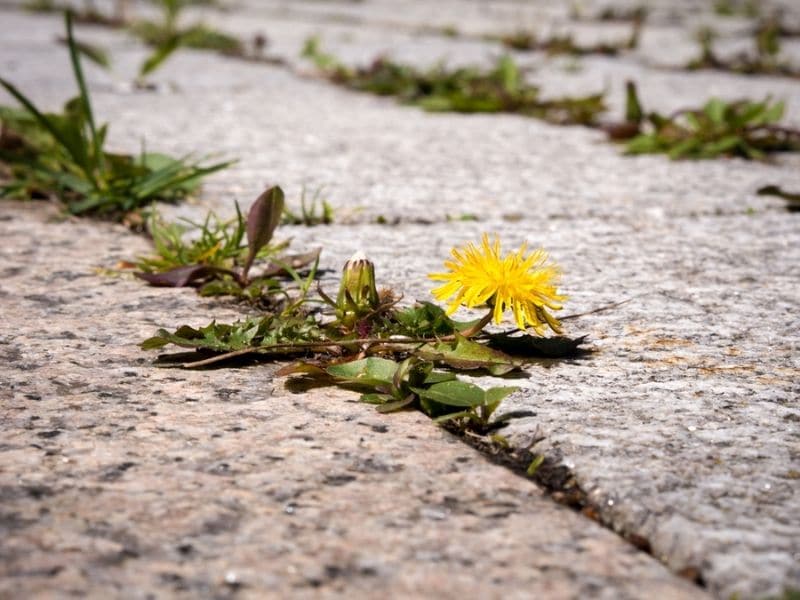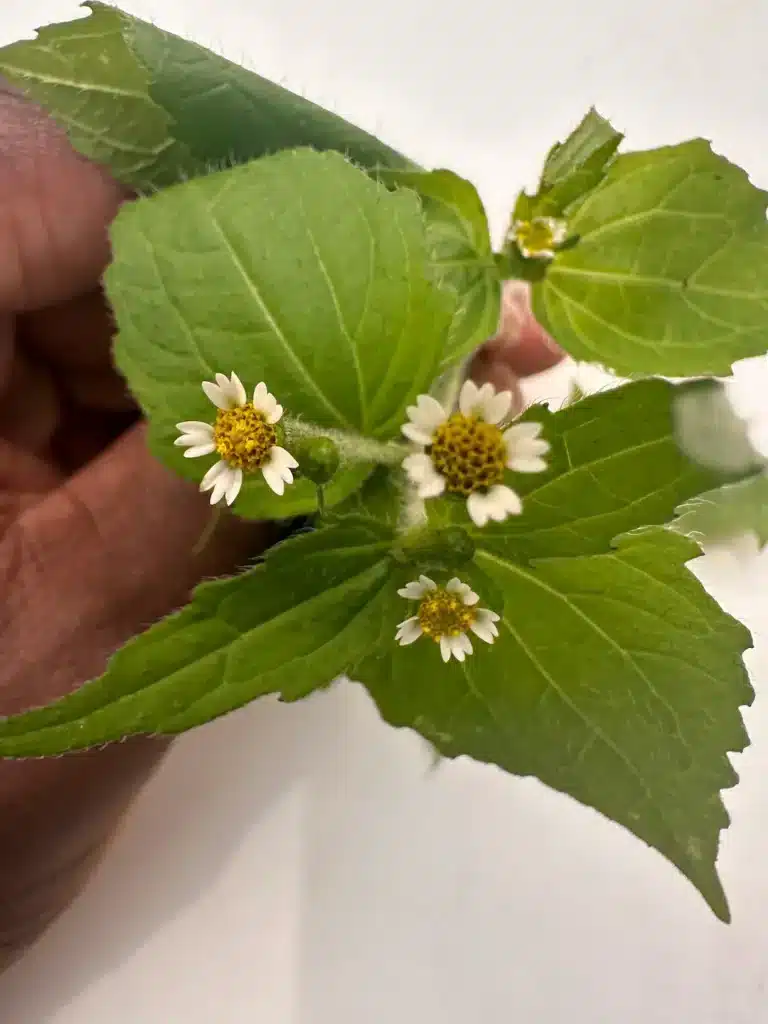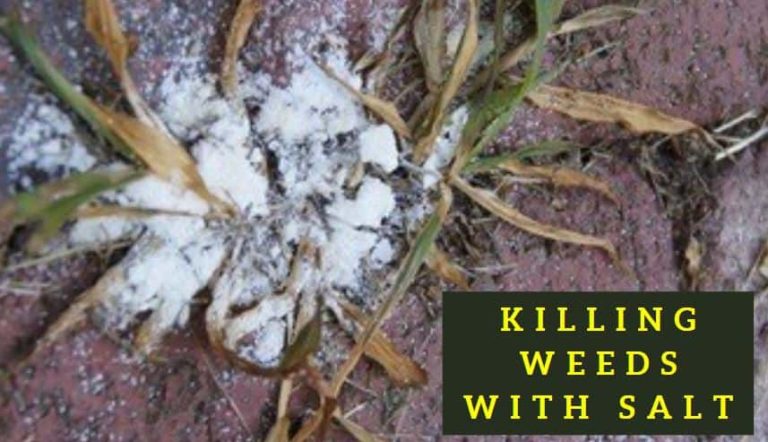Does Bleach Kill Weeds and Grass? Here’s How to Use it
Weeds and grass grow in driveways, between pavers, and all over the yard if not well controlled. While there are herbicides that you can use to control weeds, a homemade weed killer like bleach (Clorox) can also work. But how do you use bleach to kill weeds?
Concentrated bleach burns and kills weeds permanently, meaning they’ll not sprout back where it is applied. To use it, spray undiluted bleach on weeds and grass and let it sit for 3 days to destroy them to the root.
I recommend uprooting stubborn weeds that may regrow from underground rhizomes even after killing them with bleach.
You can use Clorox to safely control weeds on pavements, driveways, gravel, and patio pavers. Avoid spraying bleach on lawns and desired plants.

It is safer to spot-treat weeds with bleach because it is a nonselective DIY herbicide. If you’re using a garden sprayer, aim carefully and apply only on undesired plants. Alternatively, you can use selective herbicides to prevent damage to ground-cover vegetation in your yard.
Contents:
Does bleach kill weeds permanently?
Bleach permanently kills weeds and grass by increasing the soil pH so much that no plants can survive or grow in the area in which it is applied. Bleach is great for controlling weeds in driveways, between pavers, rocks, and on gravel for good.
CAUTION: Do not apply bleach as a weed killer in your flower beds, lawns, or if you’re growing grass between your patio pavers. It will kill any kind of vegetation when applied and affect the soil pH for a long time, thus preventing any weeds and grass from growing in those areas.
How to use bleach to kill weeds
Bleach contains concentrated amounts of chlorine. When in small quantities, it is beneficial to plants, but in high concentrations, such as in the case of bleach, the chlorine will burn and kill plants due to its highly alkaline pH.
Here’s how to use bleach to kill weeds and grass:
- Pour undiluted bleach into a garden spray pump.
- Spray the bleach directly onto the weeds in your yard, between pavers and driveways.
- Repeat the application after 2-3 days on weeds and grass that did not die.
- Pull out the dead weeds to keep the yard clean.
Pro tip: If you sprayed a diluted bleach solution on weeds, you might want to repeat the application 2-3 times to kill some stubborn weeds such as crabgrass, dandelions, creeping charlie, horsetail, and wild onion.

Chlorine bleach affects plants’ and weeds’ growth in two ways. First, the sodium content overworks the plant’s system with salts. While chlorine is a necessary part of the soil, too much can cause a condition called chlorine toxicity. Also, concentrated bleach has a pH of 11, which increases the soil’s pH crucially.
High pH levels inhibit the intake of nutrients such as calcium, iron, and magnesium essential for proper plant growth. With salt-jammed passages and insufficient nutrition, plant leaves turn brown and look burnt, and the plants may fall all their foliage. Once the bleach has penetrated, the soil is no longer suitable for planting for that season.
PRECAUTIONS
Bleach is very corrosive and can burn your skin and irritate your eyes. It can also cause staining and damage to concrete surfaces. Take proper care when using bleach as your DIY weed killer.
Here are the precautions to take when using bleach to kill weeds:
- Wear gloves and safety goggles at all times.
- Make sure it is not windy on the day you plan spray bleach. The spray particles might be blown into your eyes, nose, and ears.
- Always do a pre-test before spraying the whole garden.
- Make sure there are no children, elderly people, or animals near as you spray.
- Avoid using excess bleach on your garden soil. Wait a few days to check the results.
- Do not mix with other chemicals without investigating how they may react.
If you plan to plant anything in the same spot, flash it down with a lot of water to dilute the alkalinity in the soil. Repeat flashing for several months before planting. Also, add some manure and fertilizer to neutralize the alkalinity. Use a soil pH meter to test if the pH has stabilized.
Alternative Bleach Mixtures for Weeds
The chlorine amount in bleach is highly concentrated and can be very harmful to the soil in your yard. Some organisms that are beneficial to the soil in your yard may not survive if you use a concentrated bleach solution to kill weeds.
Here are alternative bleach homemade weed killers:
Bleach + Dawn Dish Soap
Mix 1 cup of water with 1 cup of Clorox. Add 1 tablespoon of dish soap and mix the ingredients well. Pour the solution into a plastic garden sprayer. Spot-spray the weeds in your yard, driveways, walkways, and gravel areas with the solution and let it sit for 2-3 days to kill weeds and grass.
Note that the dawn dish soap acts as a surfactant, helping the vinegar solution stick onto the leaves of weeds. This way, the bleach will be more effective at getting rid of stubborn weeds.
Bleach + Vinegar Solution
Vinegar is a great weed killer especially when undiluted. You can use it together with bleach to make a more potent homemade herbicide. Do not dilute the two especially if you’re dealing with an extensive weed problem.
Apply household vinegar directly on weeds between pavers and driveways to kill and prevent weeds from sprouting. Follow the application with a light bleach spray to make sure the weeds are permanently dead.
READ MORE: Bleach vs Vinegar – Which One is a Better Weed Killer?
Note: It is not advisable to mix two household chemicals such as bleach and vinegar because they can cause an unwanted reaction.
Where to use bleach homemade weed killer
weeds have seeds carried by wind and may land in between cracks. Since it’s not advisable to use bleach on lawns, it works best for block paving, driveways, and concrete areas. The roots of weeds in between cracks cannot be removed hence allowing the weed to regrow.
Driveways and walkways
Sidewalks and driveways are common places in the yard where weeds grow. The cracks and crevices accumulate soil on which weeds and unwanted grasses germinate.
Since you do not want any vegetation growing in your sidewalks and driveways, pour undiluted bleach on the weeds and let it sit for 2-3 days. Uproot the dead weeds to keep the driveways clean. You can also use a scraping tool to remove any small weeds that may be difficult to hold and pull out.
Warning: Bleach may discolor your driveways or any hard surface if used to kill weeds growing in the cracks.
Gravel and rocks
Gravel driveways can be problematic with weeds, especially if the gravel does not cover the soil beneath it. The best way to fix a gravel driveway overgrown with grass and other weeds is to use concentrated bleach or vinegar sprays.
Spray undiluted bleach onto the weeds in your driveway to cover all the weeds effectively. Repeat the application after 2-3 days to ensure all the weeds are killed, and then uproot them for a more pleasant yard appearance.
Between pavers
Some weeds grow between pavers because of the spaces they crawl into. Common Bermuda grass, for example, can be a stubborn weed that’s very difficult to kill.
If you have broadleaf weeds between pavers, you can pull them up with your hand or use a weed puller. Alternatively, pour Clorox into the spaces between pavers to kill weeds and grass and prevent any vegetation from growing in these spaces.
How long does it take for bleach to kill weeds?
Bleach is highly basic (alkaline) and will take 2-3 days to kill weeds. You’ll see weeds turning brown, wilting, and drooping. All these are signs of weeds dying due to the action of Clorox bleach.
Depending on how hard the grass is, it might take a little longer than 3 days to kill weeds and grass. Therefore, it may take more than a single round of spraying bleach onto the weeds to kill them faster and permanently.
How long does bleach stay in the soil?
Bleach contains chlorine which makes it basic. When poured into the soil, it breaks into chlorine gas. Sunlight and rainwater can make bleach stay for about 2 days as it breaks down and becomes weaker and weaker.
However, large amounts of Clorox can remain in the soil for a long time and deter any plants from germinating in the area.
Tips to Prevent Weeds in Driveways, Gravel or Rocks
If you’re facing a recurrent weed problem, here are a few tips to help you prevent them:
- Seal cracks in your yard, pavers, and pavements
- Pull the weeds before they seed, or use bleach to burn and kill them.
- Fix landscaping fabric or a geotextile mesh before setting up hardscapes. This mesh will inhibit weed growth.
- Salt the earth. Salt is an inexpensive way of sterilizing the ground so that nothing will grow on it. However, be careful not to pour salt on neighboring useful plants.
- Keep your gardening tools clean. Always wash your gardening tools after use. Weed seeds can easily be transported even if you are carrying the shovel to its storage place. You could unknowingly be depositing the seeds on the way.
Video
My Conclusion
Bleach is a non-selective type of herbicide. This means it will kill anything that comes in its way, weeds, grass, or even your desirable plants. While at it, bleach reduces the soil’s viability for growing plants.
Therefore, even though it may not be the most suitable and environmentally friendly option bleach does kill all types of weeds.
Since bleach harms other plants, it’s best used in places covered with concrete or areas where you don’t plan to grow other plants. If you’re unsure how to use it, getting a professional to ensure you don’t accidentally harm other plants or damage your driveway is better.
References + Resources
- University of Illinois Extension: Homemade herbicide considerations
- Richard Beard – May 7, 2014, USU Extension: Are There Home Remedies for Weed Control?



![How to Get Rid of Weeds in Mulch Beds [+ Stop Them]](https://gardenine.com/wp-content/uploads/2021/02/Weeds-in-Mulch-Beds-control-and-killing-weeds-in-mulch-beds.jpg)


Bleach is a base, not an acid, so it raises the pH and eventually kills plants indiscriminately.
All these years and I didn’t know about the bleach trick. My neighbor put in a double fence (why is the eternal question) and then died. So I am left to deal with the weeds that grow in the 8 inch space left behind by his stupid double fence. I can’t afford to pull up my fence and it took a young lawn man to tell me just to bleach between the fence. Looks like a doable fix for this ten year nuisance. I don’t want anything to grow between the fence as I can’t get a weed whacker or tool between the fence let alone my hand to pull the weeds. Where has this young man been? I also have to laugh about not doing this around the elderly. I am elderly – and I am gonna do it! Thank you for the professional endorsement and I thought I knew everything. Chuckle!
Hello Heather,
I’m glad you found my article helpful. I’ll be adding some before and after videos and photos soon.